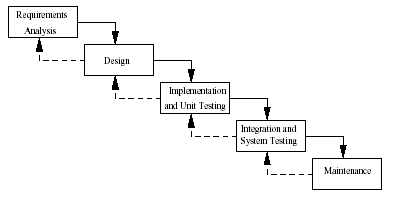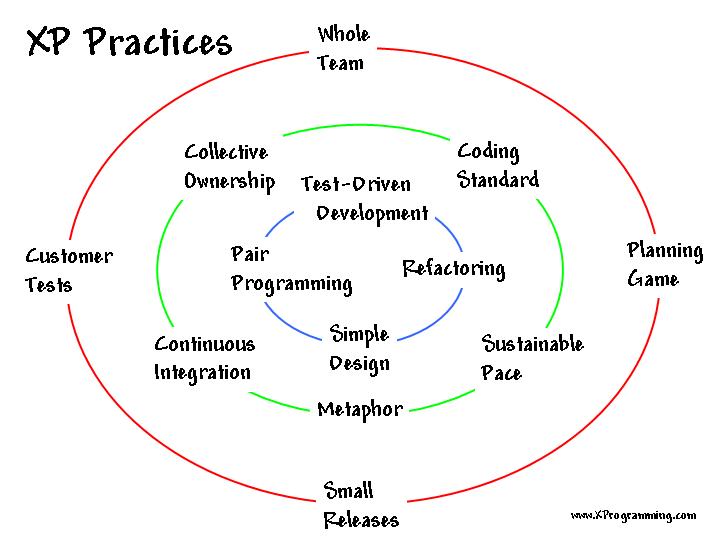| Contents [0/18] |
| Overview of Today's Class [1/18] |
| An Example Homework Solution [2/18] |
| Java Collections: Overview [3/18] |
| Software Development [4/18] |
| Software Development: Desired qualities [5/18] |
| Incremental/Iterative Development [6/18] |
| Rational Unified Process [7/18] |
| eXtreme Programming [8/18] |
| UML [9/18] |
| UML: Tools [10/18] |
| UML: Why? [11/18] |
| Use Cases [12/18] |
| UML Class Diagrams: Basics [13/18] |
| UML Class Diagrams: Classes [14/18] |
| UML Class Diagrams: Relationships [15/18] |
| CRC Cards [16/18] |
| Package Diagrams [17/18] |
| Homework [18/18] |
| Overview of Today's Class [1/18] |
Review Homework assignment
Introduction to the UML.
CRC Cards
Development Methodologies
More 00/Java
Homework Assignment #2
| An Example Homework Solution [2/18] |
So...here's one possible solution.
MyFavoritePoem.java
|
If you had trouble with this homework, you need to evaluate whether you can handle the workload in this class. If you know what you need to learn, you can learn it, but the Java details will not be covered in this class (at least not continually). If the homework was trivial, you have a good grasp of the Java command line tools and your OS. You should be able to move onto the advanced topics right away. If you struggled a bit (it happens to everyone) but knew how to find the answer in the documentation, then expect to have to do that every week in the homework assignment. But you will need to add a couple orders of magnitude into the complexity over the course of the quarter |
| Java Collections: Overview [3/18] |
Bags - a.k.a MultiSets. This is a Collection in Java
Sets - unorderd collection. This is a Set or
SortedSet in Java
Lists - ordered collection - This is a List in Java
Map - unordered collection of key/value pairs. This is a Map
or SortedMap in Java.
Iterator - allows traversal of a Collection
| Software Development [4/18] |
Software Development usually involves:
In the waterfall process, these were just done in big blocks, one at a time

| Software Development: Desired qualities [5/18] |
Usefulness
Timeliness
Reliability
Maintainability
Reusability
User Friendliness
Efficiency
| Incremental/Iterative Development [6/18] |
When doing OO development, it has become clear over the years that the old style of waterfall life-cycle development consisting of analysis, design, and construction doesn't work (but companies companies continue to use it anyway).
This doesn't mean uncontrolled development with no planning
Instead, each increment of the system builds a subset of the entire system. An increment includes
Before the first increment is executed, an exploration phase is entered. This phase consists of
|
How long should each iteration be? Some say as little as 2-3 weeks (XP) whereas many say 2-3 months. It depends on the project and the developers. For this class, it will need to be 1-2 weeks for the project so that enough iterations can be completed before the project is due. Increments should always start with the hardest parts first. A usable product should be delivered to the user as soon as possible. The increments will need to be testable. This can assure whether or not the requirements and project plan is being met. |
| Rational Unified Process [7/18] |
The Rational Unified Process is a process that was developed by Rational Software. They define it and sell it as a product that integrates with other tools that they sell, but the process can be used separately from the tool.
The key practices of RUP are:
There are 9 models
There are 9 process workflows
There are 4 phases to RUP:
The last three phases may contain multiple iterations.
Certain documents are maintained throughout the project:

| eXtreme Programming [8/18] |
"Extreme Programming is a discipline of software development based on values of simplicity, communication, feedback, and courage. It works by bringing the whole team together in the presence of simple practices, with enough feedback to enable the team to see where they are and to tune the practices to their unique situation."
There are 13 core practices in XP.

| UML [9/18] |
The Unified Modeling Language is the successor to a number of Object-Oriented analysis and design (OOA&D) languages
The UML is a language, not a development methodology (we'll talk about methodologies later). It is a language for visualizing, specifying, constructing, and documenting.
OO Modeling languages started to appear in the late '70s and early '80s, with more than 50 approaches in the early '90s
Mostly a combination of the work of Booch, Rumbaugh, and Jacobson (the three amigos)
Three goals stated for the UML
By the later '90s, most notable software tool vendords had adopted the UML as their OO modeling language
UML maintenance (of the specification) is now under the control of the Object Management Group (OMG)
| UML: Tools [10/18] |
What about tools for UML?
Most companies select a UML tool that integrates with their IDE and programming languages
Unfortunately, most of these are fairly complex and expensive. However, in the past few years, a number of free versions, and open source versions, have come available. There is a list at http://www.objectsbydesign.com/tools/umltools_byCompany.html that you might find helpful. Unfortunately, I don't have time to review any of the tools or give you support on using them, but you are encouraged to try some of them. I will always accept drawings by hand for the final project (assuming they are legible and correct).
I have tried Posieden and ESS-Model. You may find others more (or less) helpful. Some of the non-free versions have limited time versions that might work for this class.
Newer versions of Visio support most of the UML diagrams, but will not support reverse engineering of code (from non Microsoft tools).
| UML: Why? [11/18] |
Importance and Principles(from The Unified Modeling Language User Guide, by Booch, Rumbaugh, and Jacobson):
Importance
Models help us:
You need models for larger systems because you cannot comprehend the system in its entirety
Principles of Modeling
| Use Cases [12/18] |
Use Cases exist to capture the intended behavior of a system without having to specify how the behavior is implemented. They are very good for specifying user requirements, and for developing good user acceptance tests
Example: p 45-46
Scenario: a sequence of steps describing an interaction between a user and the software system.
Use Case: a set of scenarios that meet a common user goal. Each use case has a name as well.
Use cases are written out as a series of Main Success Scenarios (Main flow of events), and a set of alternative Scenarios (Exceptional flow of events)
Use cases describe what not how
Use cases can be diagrammed using UML. They consist of actors (users of the system) and the use cases that they interact with. The actors carry out the use case.
Use cases can use inclusion and extension. Both of these cases help you save time writing and diagramming. This is similar to generalization, but it limits the generalization to only certain extension points. It is a special case.
For use cases c1 and c2
| UML Class Diagrams: Basics [13/18] |
Three perspectives
Conceptual - not a direct mapping to classes. Generally is language independent.
Specification - Interfaces, not the implementation. Types rather than classes.
Implementation - lays the entire thing bare.
Shows classes, interfaces, and their relationships (collaborations, generalizations, associations, and dependencies)
| UML Class Diagrams: Classes [14/18] |
Notation:
Top is the class name (required)
Fields (attributes in UML) in the middle. Two types of syntax: Java or UML.
Java Syntax: [Visibility] [Type] Name [[Multiplicity]] [= Initial Value]
UML Syntax: [Visibility] Name [[Multiplicity]] [:Type] [= Initial Value]
Methods (operations in UML) on the bottom. Two types of syntax: Java or UML.
Java Syntax: [Visibility] [Type] Name ([Parameter,...])
UML Syntax: [Visibility] Name ([Parameter,...]) [:Type]
Visibility can be one of
public)private)protected)Parameters in UML are given Name:Type, in Java Type Name
Class Diagrams can be given in abbreviated forms
Static is indicated by underlining the method
Stereotypes are used to extend the UML. It is like an adjective to describe a core UML type and make it better understood when there is not UML type to describe exactly the role you are assigning a part of your model
Interfaces are drawn as a stereotype of a class (older versions will show a circle)
Constructors can be distinguished from other methods by using a Constructor stereotype
Ellipsis (...) are used to show that more methods or variables exist that aren't shown
| UML Class Diagrams: Relationships [15/18] |
Relationships
Association - relationships between instances of Types.
Aggregation
Composition
Generalization (Specialization)
Dependency - dashed arrow with open arrowhead
Constraint Rules
UML uses { } to show contraints.Design By Contract and assertions will be used to enforce contraints. This is native to languages like Eiffel. We'll talk more about this later.
Examples: p 31,33,35
| CRC Cards [16/18] |
CRC (Class-Responsibility-Collaboration)
On a 4x6 card, write Class
Responsibility = summary of attributes and methods. A high level description of the purpose of the class.
Collaborations = classes needed by this class to fulfull its resonsibilities.
Very informal. Meant to promote discussion. Use with Class and Interaction diagrams.
| Package Diagrams [17/18] |
Used for larger systems to show dependencies between packages.
Packages dependencies are not transitive.
The goal is to keep dependencies to a minimum.
Note: Java's package import statement can be easily
broken. Dependencies could exist that you don't see in the
import statements.
Example: p 26
| Homework [18/18] |
Read Jia Chapters 4 and 5. Pay special attention to the StringTokenizer, the BufferedReader, and the FileReader as you read chapter 4.
Read pages 1-23 of Principles and Patterns by Robert Martin.
Goal: Learn more of the Java APIs. Practice writing more code, debugging, and using multiple source files. Develop some base code for further homework assignments. Improve practices from first homework assignment.
Assume that you have a file of flight records. It is a text file in which each line contains a single record, and each record consists of the following colon-delimited fields:
Airline Code: Airplane Type: Flight Number : Departing Airport : Arriving Airport: Time
A sample line is as follows:
ASA:B73Q:144:ORD:SFA:13
Assume that the time is just a whole hour in 24HH format, as an integer. All other records are strings
Write a Java application that will read in a data file from a command line argument and do the following:
Implement the solution in at least two source files, one called
se450.studentid.hw2.Main, one called
se450.studentid.hw2.Airline, and one called
se450.studentid.hw2.Flight. Replace studentid
with your DePaul id.
Choose a good container for the flights as you work with them in your code, and use an Iterator when you have to traverse the collection of flights.
The Flight class should contain a reference to the Airline, and store the airport codes and airplane types as Strings. The time should be stored as an Integer.
Override toString to provide a meaningful String
representation of the flight.
The program should take one argument, the filename of data, and
provide the output for parts (a), (b), and (c) all at once. If you are
having trouble with "screen blindness", then redirect the output to a
file for offline reading like this:
java se450.studentid.hw2.Main flights.txt > output.txt
Ask questions on the discussion board!
Submit
a zip
file that contains all necessary .java files as
well as grader.txt, in the correct package structure,
just as last week.
Don't include any class files
Due next Monday at 5:30 PM.
Revised: 2003/1/12